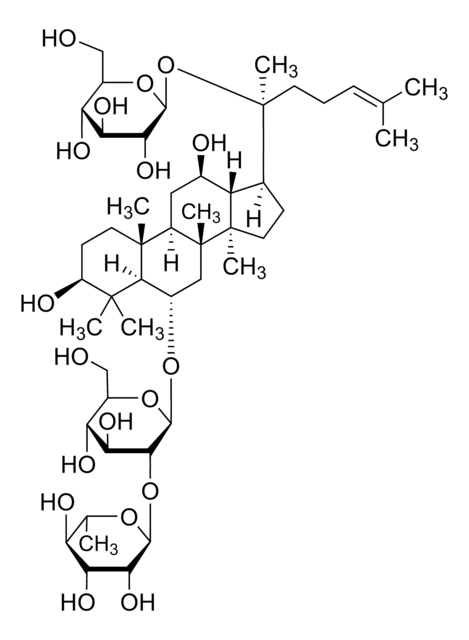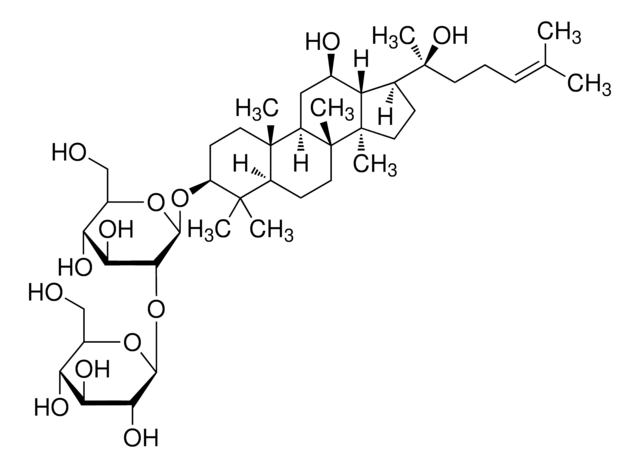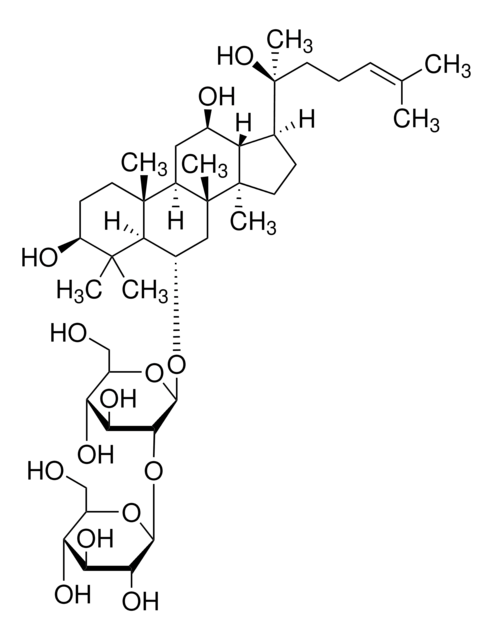41868
Ginsenosid Rb2
analytical standard
Synonym(e):
(3β,12β)-20-[(6-O-α-L-Arabinopyranosyl-β-D-glucopyranosyl)-oxy]-12-hydroxydammar-24-en-3-yl-2-O-β-D-glucopyranosyl-β-D-glucopyranosid, NSC 308878
About This Item
Empfohlene Produkte
Qualität
analytical standard
Qualitätsniveau
Assay
≥95.0% (HPLC)
Haltbarkeit
limited shelf life, expiry date on the label
Methode(n)
HPLC: suitable
gas chromatography (GC): suitable
Anwendung(en)
food and beverages
Format
neat
Lagertemp.
2-8°C
SMILES String
C\C(C)=C/CC[C@](C)(O[C@@H]1O[C@H](CO[C@@H]2OC[C@H](O)[C@H](O)[C@H]2O)[C@@H](O)[C@H](O)[C@H]1O)[C@H]3CC[C@]4(C)[C@@H]3[C@H](O)C[C@@H]5[C@@]6(C)CC[C@H](O[C@@H]7O[C@H](CO)[C@@H](O)[C@H](O)[C@H]7O[C@@H]8O[C@H](CO)[C@@H](O)[C@H](O)[C@H]8O)C(C)(C)[C@@H]6CC[C@@]45C
InChI
1S/C53H90O22/c1-23(2)10-9-14-53(8,75-47-43(67)39(63)37(61)29(72-47)22-69-45-41(65)34(58)26(57)21-68-45)24-11-16-52(7)33(24)25(56)18-31-50(5)15-13-32(49(3,4)30(50)12-17-51(31,52)6)73-48-44(40(64)36(60)28(20-55)71-48)74-46-42(66)38(62)35(59)27(19-54)70-46/h10,24-48,54-67H,9,11-22H2,1-8H3/t24-,25+,26-,27+,28+,29+,30-,31+,32-,33-,34-,35+,36+,37+,38-,39-,40-,41+,42+,43+,44+,45-,46-,47-,48-,50-,51+,52+,53-/m0/s1
InChIKey
NODILNFGTFIURN-GZPRDHCNSA-N
Suchen Sie nach ähnlichen Produkten? Aufrufen Leitfaden zum Produktvergleich
Anwendung
Verpackung
Sonstige Hinweise
Signalwort
Warning
H-Sätze
Gefahreneinstufungen
Acute Tox. 4 Oral
Lagerklassenschlüssel
11 - Combustible Solids
WGK
WGK 3
Flammpunkt (°F)
Not applicable
Flammpunkt (°C)
Not applicable
Choose from one of the most recent versions:
Besitzen Sie dieses Produkt bereits?
In der Dokumentenbibliothek finden Sie die Dokumentation zu den Produkten, die Sie kürzlich erworben haben.
Kunden haben sich ebenfalls angesehen
Artikel
Optimize HPLC method for ginsenoside separation using a mixture, applying it to American Ginseng root, with conditions and chromatograms shown.
Unser Team von Wissenschaftlern verfügt über Erfahrung in allen Forschungsbereichen einschließlich Life Science, Materialwissenschaften, chemischer Synthese, Chromatographie, Analytik und vielen mehr..
Setzen Sie sich mit dem technischen Dienst in Verbindung.
















